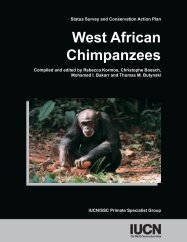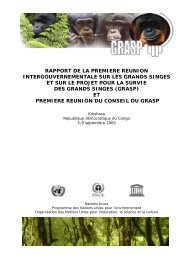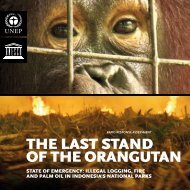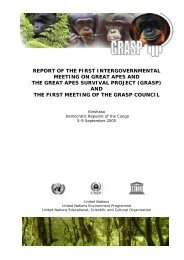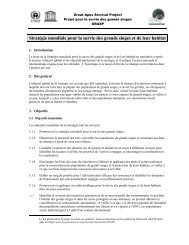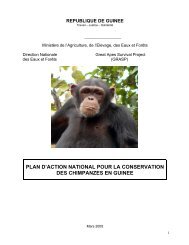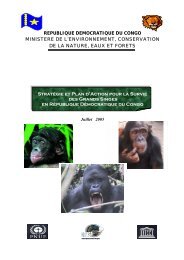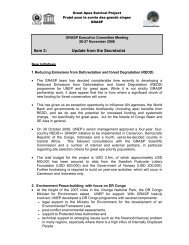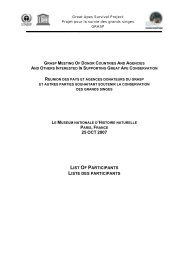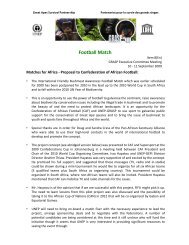THE LAST STAND OF THE - GRASP
THE LAST STAND OF THE - GRASP
THE LAST STAND OF THE - GRASP
You also want an ePaper? Increase the reach of your titles
YUMPU automatically turns print PDFs into web optimized ePapers that Google loves.
ROLE <strong>OF</strong> MULTINATIONAL COMPANIES<br />
AND NETWORKS<br />
FDLR, CDNP and even FADRC have been involved in transport<br />
of timber, minerals and charcoal from illegal exploitation<br />
(UNSC, 2008). FDLR controls many mines in North and South<br />
Kivu and are involved in trafficking minerals by roads and<br />
trucks from Walikale and controls the vast majority of territory<br />
in the mineral-rich Kahuzi Biega National Park.<br />
There are several comptoirs involved in selling the minerals<br />
on to companies such as Groupe Olive, Etablissement Muyeye,<br />
MDM, World Mining Company (WMC) and Panju, that are the<br />
main recipients of and top exporters of cassiterite, coltan and<br />
wolframite – with government export licences (UNSC, 2008).<br />
Etablissement Namukaya is also involved in pre-financing gold<br />
purchases from FDLR territory (UNSC, 2008). CNDP for example,<br />
also make revenues from taxing of the minerals, such<br />
as 0.20 USD per kilogram of minerals at checkpoints set up<br />
near or around mines (UNSC, 2008). As the mineral production<br />
in the region is at least 15,000 tons a year, the incomes to<br />
the militias from these “road” taxes are thus also here millions<br />
of dollars annually.<br />
It is also likely that the actual exports are much higher even<br />
than this. As many of the companies or their subsidiaries –<br />
unlike the multinational buyers – are also fronts for some of<br />
the militias, it is clear that the incomes from the exploitation<br />
of resources in the region and the taxes are central in the continuation<br />
of the conflict. It also appears that that much of the<br />
low-profile “taxing” in villages etc is done to finance some of<br />
the troops on a daily basis, whereas as the really large sums<br />
never reach the low-level troops, who are frequently left to obtain<br />
their needs through direct plundering.<br />
The official exports in 2007 from DRC were 14,694 tons of<br />
cassiterite valued at 45 million USD, 1,193 tons of wolframite<br />
valued at 4.27 million USD, and 393 tons of coltan valued at<br />
5.42 million USD (UNSC, 2008). These numbers are around<br />
61–70% of what the official production estimates are listed as<br />
(UNSC, 2008). Furthermore, one – out of many – company,<br />
Traxys, alone officially exported 226 tons of coltan in 2007 – or<br />
near 57% of the entire official coltan export from the DRC according<br />
to the Groups of experts (UNSC, 2008). Receipts and<br />
records of the five major comptoirs buying minerals, including<br />
coltan and cassiterite, traded minerals for an average of 9.77<br />
USD/kg per day in May 2008 (UNSC, 2008). Summarizing<br />
the purchases across a total accumulated period of 66 days, the<br />
companies M.G.M, ETS Panju, MDM, Muyeye and Amur purchased<br />
an average of 29.45 tons per day of an average cost of<br />
65,127 USD (records archived at UN, New York; UNSC, 2008).<br />
It is impossible to verify the extent of the illegal exploitation<br />
in exact numbers. However, the taxing alone of 0.2 USD per<br />
kg around the road systems of minerals estimated to be at<br />
least 2–10 times higher than official exports which for coltan,<br />
cassiterite and wolframite combined then becomes around<br />
32,000–150,000 tons of minerals annually, suggesting an income<br />
of near 6–30 million USD alone on road taxes on minerals<br />
to the militias, around 4 million USD on charcoal, and most<br />
likely similar for other goods combined. In addition gold and<br />
diamonds are also involved. With taxes also on trucks, other<br />
goods like cement, timber and charcoal, charcoal reported to be<br />
at least 0.7 million USD alone at some border crossings in addition,<br />
not including the transport inside the DRC, suggest that<br />
the militias are making an income of anywhere between 14–50<br />
million USD annually on taxes alone, most likely much more.<br />
In addition, the militias are heavily involved also in the fronts<br />
and in many of the actual local companies or fronts based in<br />
among other Kampala and Nairobi (UNSC, 2008). It is therefore<br />
clear that the militias and subsidiary companies involved<br />
Figure 3: Companies originating in the EU, and companies based in Austria, Belgium, Canada, China, Hong Kong (China), India,<br />
Malaysia, Thailand, Rwanda, South Africa, Switzerland, The Netherlands, The Russian Federation, The United Arab Emirates, and<br />
the UK and Northern Ireland are involved in exporting minerals and timber from conflict regions in the DRC (UNSC, 2008). Principle<br />
export points are Mombasa and Dar Es Salaam.<br />
28



